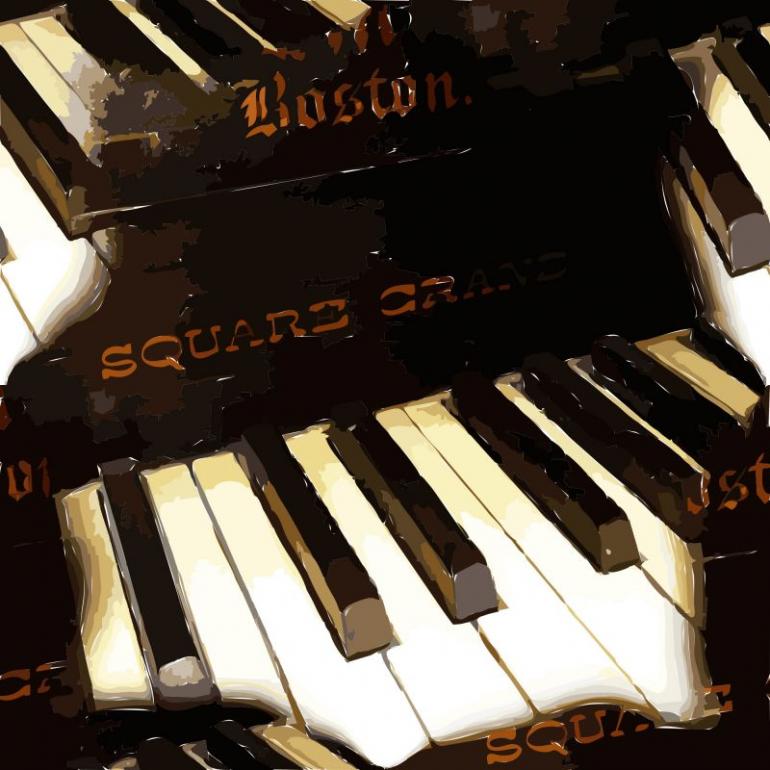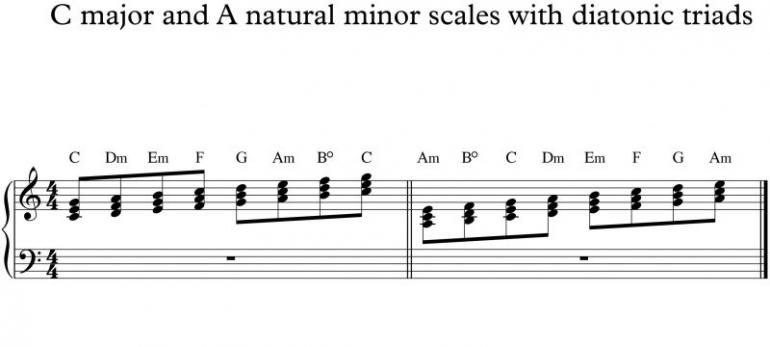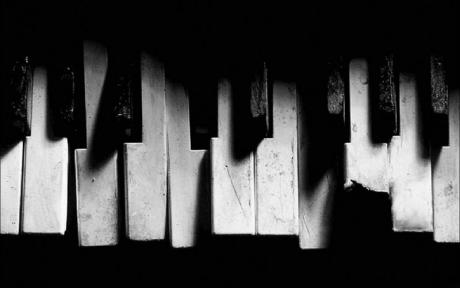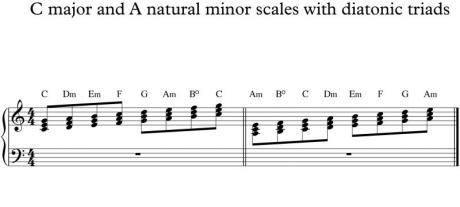Rockové klávesy - Rocková harmonie: A jsme tu s príma akordy pro vaše písničky

Rock Harmony: Coming up with Cool Chord Progressions for your Original Music
Greetings Readers, and welcome to another edition of Rock Keyboards! I hope you are all staying safe and practicing hard to make good use of our time inside. This month, I wanted to talk about harmony, specifically as it relates to composing chord progressions for use in your own original music. In Western European classical music, most chord progressions are either in major or minor keys. If you compare modern music to that music, It’s striking how similar our chord choices have been for the last 400 years.
Major and minor scales
Most of the chord progressions you will encounter come from parent scales. The simplest scale, and the one we will use here, is the C major scale, or all the white keys on the piano from C to C. Take a look at Exercise 1. In Bar 1, we have triads with a C major scale serving as the roots of seven different chords that are commonly used in chord progressions in C. Bar 2 has the relative minor of C, A minor. Remember if you play any major scale from it’s 6th scale degree to it’s octave, in this case all the white keys from A to A, you have a natural minor scale which has a b3, b6, and b7 compared to a major scale. Notice how the chords are different in the minor harmony. To make things even trickier, there are a few different kinds of minor scales, and thus different diatonic chords. For now, this is a good start. Try letting your ears lead to interesting chord choices. For extra credit, start putting 7ths and 9ths on top of the triads.

Greatest hits for 400 years: the I IV & V chords
When music theorists speak about chords, they use Roman numerals, and we will too. This also allows you to move the progression to a different key easily if you know all your scales. The numeral corresponds to the step in the scale. For example, IV in the key of C Major is F. If the chord is minor the numeral is written in lower case. For example, iv in the key of Cm is Fm. From Bach to blues to rock and synth pop, the most important chords in both major and minor keys are the I, IV, and V chords (iv and v in Cm). Our harmonic system is all about tension and release and the IV and V chords provide the most final cadences, or resolutions. This is why they are so popular in all of the music you hear. Also, very popular choices are ii and vi (bVI in minor) and b7 which actually comes from a scale called Mixolydian (C, D, E, F, G, A, Bb, C). Try putting one of these chords before a IV or V chord to make some simple progressions. As practice, try picking four chords from the diatonic triads in whatever key you like and arrange them in simple chord progressions.

Slovníček frází a hudebního žargonu
Chord progressions: Chord znamená akord a progression pokrok nebo vývoj, případně postup. V článku je tedy slovní spojení ve významu akordový postup. Označuje se tak sekvence akordů, které tvoří harmonické spojení nebo harmonické schéma, někdy také kadence.
Major or minor keys: Key je v překladu klíč, předznamenání. Major znamená major ve smyslu vojenské hodnosti, major označuje také něco významného, v hudbě major pak znamená dur. Minor je nezletilá osoba, v hudbě je ve významu moll.
Scale: V angličtině označuje měřítko, a to doslova i obrazně, a pak také, a to nás zajímá, stupnici.
Encounter: Znamená setkání, ale také srážka. Jako sloveso potom setkat se, narazit na někoho, utkat se. V článku pak: „Většina akordových postupů, se kterými se setkáte, má původ v diatonických stupnicích.“
Bar: Bar samozřejmě znamená bar, tedy jednotka atmosférického tlaku, bar je také i bar ve smyslu pultu, přes který se servírují nápoje, má ale řadu dalších významů. Bar je totiž třeba tyčinka (sladkost), nebo tyč (ocelový prut), překážka. V hudební nauce nás zajímá význam takt.
Relative: Toto slovo znamená relativní, vztahující se (k něčemu), ale také příbuzný. A to je právě situace v článku, kde autor píše, že v druhém taktu máme mollového příbuzného C dur, tj. a moll.
This also allows you to move the progression to a different key easily if you know all your scales: Sloveso move znamená pohnout (se), pohybovat (se), stěhovat (se), v článku pak: „To vám umožní snadno transponovat akordový postup do jiné tóniny, pokud se samozřejmě dobře vyznáte ve stupnicích.“
Tension: Znamená napětí, a to jak ve fyzice, tak v hudbě. V článku ve větě: „Náš harmonický systém tkví hlavně ve vytváření napětí a následném uvolnění a v kadenci čtvrtý a pátý stupeň nabízí to nejsilnější vyvrcholení.“





